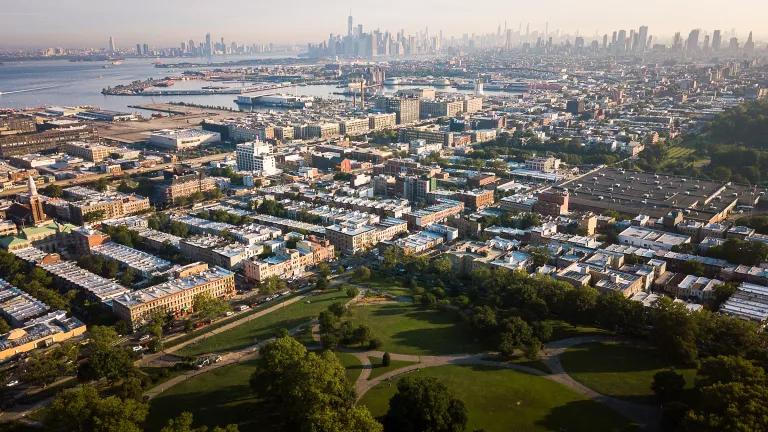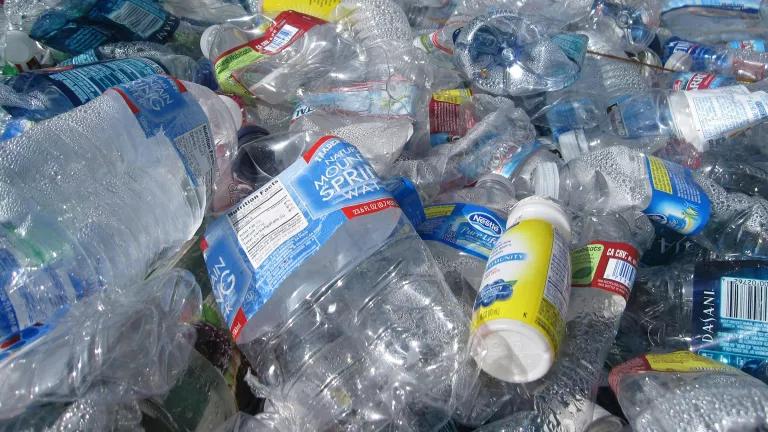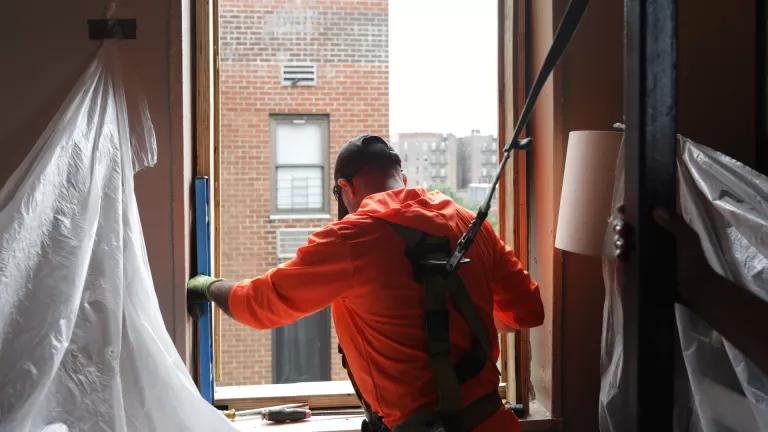NRDC’s 2024 Legislative Agenda for a Healthy and Equitable Environment in New York
The end of 2023 brought huge wins for New York and its environment. Here are our priorities for 2024.

Stefan Tomic/Getty Images
For more than 50 years, NRDC has worked to build a healthy and equitable environment for all New Yorkers. The end of 2023 resulted in huge victories for all New Yorkers as NRDC celebrated passage of its four biggest policy priorities. The Birds And Bees Protection Act established the strongest restrictions on neonic pesticides in the country. The All-Electric Building Act will reduce New York’s carbon emissions while ensuring cleaner air in new-construction buildings. New mandatory flood disclosure requirements for buildings will provide transparency on past flooding to potential homebuyers. Finally, pipeline companies are required to disclose insurance information in their applications for any pipeline that crosses a freshwater wetland.
In 2024, our state legislative priorities will center on policies that decrease our dependence on fossil fuels, improve the air quality in existing buildings where we live and work, and fight toxic chemicals from entering our state’s environment.
Ending our dependence on fossil fuels
New York HEAT Act
New York’s climate goals and clean energy transition are threatened by existing laws on natural gas that perpetuate, promote, and subsidize its use. The NY Home Energy Affordable Transition (HEAT) Act seeks to eliminate these legal barriers so that state regulation of utility gas service supports the climate and equity goals of the state's Climate Leadership and Community Protection Act (CLCPA). This landmark legislation aims for net zero greenhouse gas (GHG) emissions by 2050 and emphasizes equitable climate change solutions, particularly for disadvantaged communities.
The NY HEAT Act aligns the state’s gas utilities with the CLCPA by empowering the Public Service Commission to achieve its targets and make strategic gas planning a regulatory goal. It does so by amending existing laws to adjust the gas utility’s “obligation to serve” and the rules subsidizing new gas system interconnections. This allows the Public Service Commission to plan and implement the downsizing and decarbonization of gas utility systems in a manner that is equitable, orderly, and affordable.
The NY HEAT Act further supports a strategic transition of utility infrastructure with community-scale alternatives to traditional gas infrastructure as it enables gas utilities to redirect investments toward replacing existing gas infrastructure with cleaner, greener electrification solutions. The NY HEAT Act will mitigate the costs of transitioning utility infrastructure and protect vulnerable customers from price hikes. The act also ensures equitable cost distribution, codifying the state’s long-held goal that no household should spend more than 6 percent of its income on energy bills, while limiting the amount of costs that can be shifted from low-income households to other utility customers.
Fighting CO2 drilling
We know fracking wreaks havoc on our health and environment. A decade ago, New York led the nation in banning high-volume hydraulic fracking. Now, to circumvent the law, the fossil fuel industry is proposing to use carbon dioxide (CO2) to extract natural gas. Since the fall of 2023, a Texas-based company has been asking landowners in the Southern Tier of New York to lease their land for gas extraction through the injection of carbon dioxide into the Marcellus shale formation, the same area where companies had previously wanted to frack. CO2 drilling poses the same threats to our climate, water, and health as hydraulic fracking—and it must be stopped. Bills S8357 (State Senator Lea Webb)/A8866 (Assemblymember Anna Kelles) would prohibit using carbon dioxide to drill and extract natural gas and oil.
The Fashion Act
The fashion industry is said to produce 2 to 8.6 percent of our global GHG emissions, and at its current growth rate, it will make up 25 percent of our global GHG budget by 2050. The Fashion Act, from S4746 (State Senator Brad Hoylman-Sigal)/A4333A (Kelles), would regulate all apparel and footwear companies with more than $100 million in annual revenue that operate or sell into the state of New York. It would require these companies to (1) disclose the environmental and social impacts of their supply chains; (2) mandate compliance with a due diligence framework to reduce their GHG emissions in accord with the Paris Agreement; (3) manage their chemical use; and (4) pay workers their due wages. It is a landmark piece of legislation for an industry that has thus far escaped much regulation.
A healthy New York for everyone
Plastics and waste
A key priority for New York in 2024 is the Packaging Reduction and Recycling Infrastructure Act (A5322B/S4246B). With fossil fuel–based plastics production expected to triple by 2060 and plastic becoming a major profit center for the oil and gas industry, reducing single-use plastic production has become a climate protection imperative. Meanwhile, cities and towns around the state grapple with the burden of disposing nearly 18 million tons of municipal solid waste every year—more than four pounds per person per day. The overwhelming bulk of New York’s waste is sent to landfills and incinerators, despite the environmental problems and significant cost to taxpayers with this approach. As things now stand, manufacturers of consumer products have no incentive to cut back on the volume of single-use plastic and other packaging waste that fills up garbage trucks from Buffalo to Montauk.
Thankfully, Assemblymember Deborah Glick and Senator Pete Harckham, who chair the Environmental Conservation committees in their respective chambers, have reintroduced legislation this session that would confront the growing problem of plastic and other packaging waste head-on. The Packaging Reduction and Recycling Infrastructure Act—if passed in its current form—could set in motion once-in-a-generation trash disposal reforms. The act incentivizes manufacturers to reduce the amount of plastic and other packaging waste they produce by: establishing numerical targets that boost the use of recycled materials in packaging; requiring manufacturers, instead of municipalities, to cover the disposal costs of the packaging materials they produce; and directing the reduction of toxic chemicals in new and recycled packaging. See NRDC’s expert blog for more info.
PFAS
NRDC has been leading the charge in the formation of the PFAS-Free New York coalition, made up of environmental advocates, impacted community members, physicians, farmers, and sustainable businesses. PFAS (per- and polyfluoroalkyl substances) exposure has been linked to a wide range of health risks, like cancer and reproductive harm. PFAS-Free New York is urging legislators to take bold steps to reduce the unfettered use of PFAS, starting with unnecessary uses of PFAS in everyday products. Fifty percent of New York’s public water systems have detected some level of PFAS contamination, and this doesn’t even account for the approximately 2 million New Yorkers getting drinking water from private wells. PFAS will never stop threatening our communities and water resources if it continues to be used and manufactured.
PFAS can be found in textiles, rugs, dental floss, nonstick cookware, ski waxes, household paint, children’s products, cleaning products, personal care and cosmetics, and menstrual products. There are three bills with momentum in the state legislature that address these unnecessary uses. A3556B (Assemblymember Kenneth Zebrowski)/S5648B (Holyman-Sigal) bans PFAS in common household products; A6969 (Glick)/S4265 (Webb) bans PFAS and other toxic chemicals in personal care and cosmetic products; and A5990A (Assemblymember Linda Rosenthal)/S3529A (State Senator Nathalia Fernandez) bans PFAS and other toxic chemicals in menstrual products. Passing these four bills is a top priority this year.
Good Food New York
NRDC is working with a robust coalition to help transform New York’s regional food system by leveraging the enormous purchasing power of the state’s municipalities. The primary goal is to enact new, nation-leading legislation to enable cities and towns across the state to more easily purchase food that is healthier, better for the environment, and more equitably accessible. Right now, municipalities are hamstrung by outdated state purchasing laws that largely limit them to purchasing food that is the lowest-cost option. Under the proposed Good Food NY legislation, the state’s municipalities can pay a bit more to purchase food that is advancing six core values: local economies, nutrition, valued workforce, environmental sustainability, animal welfare, and racial equity. Additionally, the suppliers of food for the millions of meals served every year by local governments—New York City schools alone serve one million meals per day—would be required to provide greater transparency on how their products meet these six values. Good Food New York will also increase government purchasing from (often struggling) New York farms, as well as those working to create a more sustainable food system.





